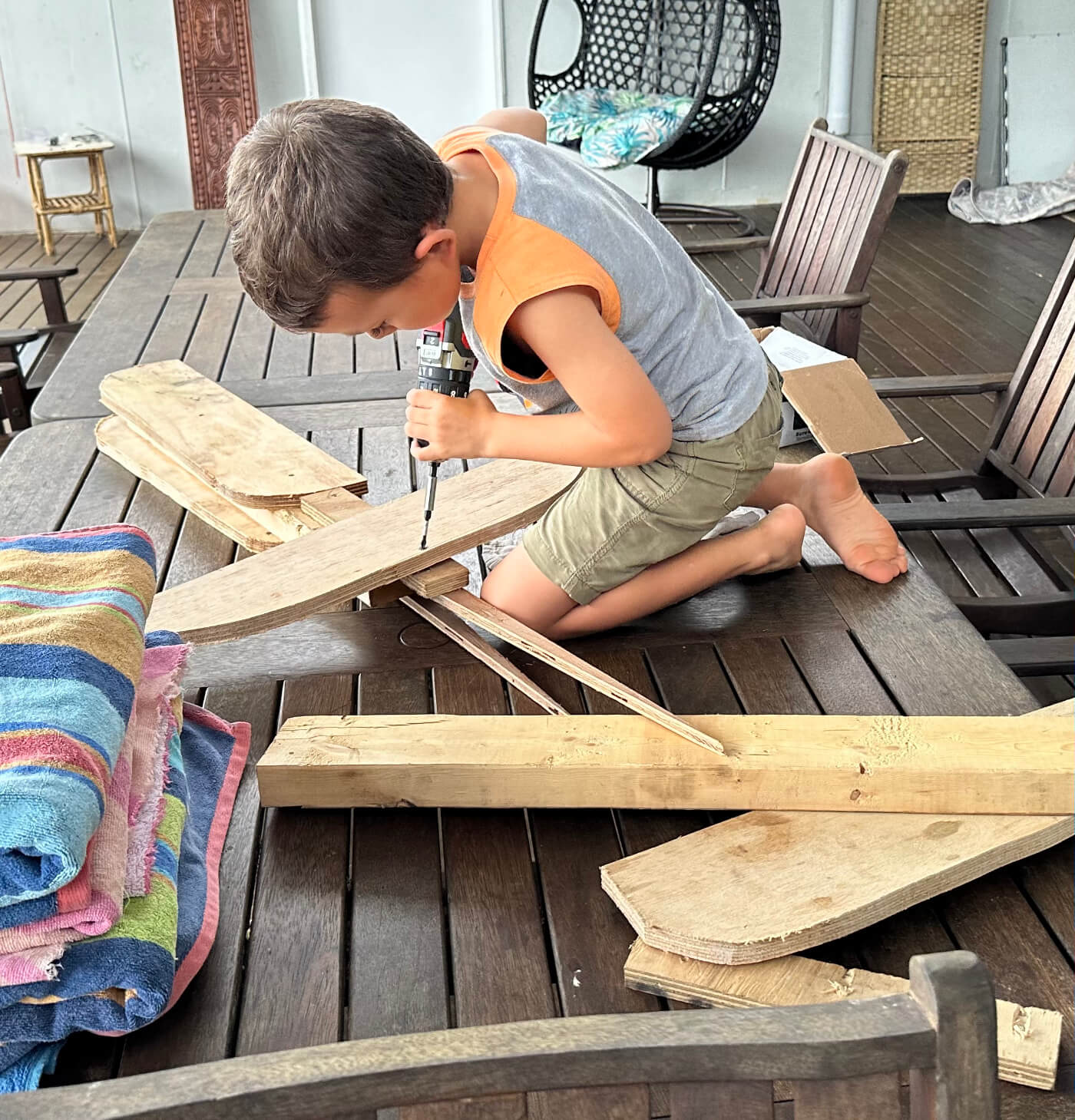Post Outline
1. Useless Backstory
2. The Theory
3. The Materials
4. The Setup
5. How Do I Know It’s Working?
6. Additional Tips (My Scenario and Mistakes)
1. Useless Backstory
Recently I had the opportunity to break off an extractor while trying to extract a broken stud. I had drilled the center of the stud out with a left hand drill, right dead in the middle. No luck. Then I had selected a name brand extractor. I did everything right up until the moment I convinced myself that if I apply just a tiny more torque to the extractor, the broken stud will suddenly pop free and spin out. It didn’t. Instead my extractor broke leaving me the hole plugged solidly with hardened steel and my soul plugged with despair.
Drilling out a hardened steel extractor is very difficult. Especially if it’s surrounded by soft material like aluminum. Your drill will inevitably wander off the bolt and quickly grab the soft material surrounding it, elongating your hole, turning a bad situation even worse.
Luckily for me my Engine Room supervisor (his name is Josh too!) had recently dealt with a similar scenario and had found this useful trick. This apparently comes from an old watchmaker’s trick. They frequently break steel screws in brass and they use this method to dissolve the screw out of the brass.
I struggled with the process but now that I’ve waded through the pain of learning, I thought I’d share. This can really save some heartache, especially if you’re in an area with limited resources (i.e. the mission field).
Two important things: Yes, it dissolves the steel. No, it doesn’t affect aluminum alloys that are alloyed with non-ferrous metals (i.e. 2024-T3 sheet metal or aluminum alloy cylinder heads). CAUTION ABOUT ANODIZED SURFACES: This process does remove anodized coating.
2. The Theory:
The theory is simple. You soak the broken steel bolt in an alum and water solution while applying heat. The heat speeds up the chemical process significantly and helps the water hold more alum solution. The solution dissolves away the steel while leaving the aluminum unchanged. Sounds too easy? Yes, it is easy. It just takes time.
3. How Long Does It Take?
If you apply heat (using a standard hardware heat lamp for reference) for eight hours a day (for example using the heat lamp only during the work day when people are in the building), it takes about four days to dissolve a broken 1/4″ stud about 1″ long.
TIP: If you drill a small hole in the center of broken stud you expose more surface area of the stud to the alum solution making it dissolve faster.
4. The Materials:
- A Funnel or some sort of delivery system. Plastic or aluminum material works best. Obviously don’t use a steel funnel or hardware since the alum will damage it severely. The bigger diameter of funnel or pipe you can use to deliver the solution, the better (I will explain why later).
- Alum powder. Just because the label says “Alum Powder” doesn’t mean it’s what you want. Check the ingredients. It must be potassium aluminum sulfate. You’ll need around 3.5 oz. You can buy this cheap at WalMart or wherever spices are sold. It’s commonly used to make pickles.
- Heat Lamp.
- Hot Water. At least 2.5 cups.
- Mixing container capable of holding 2.5 – 3 cups of hot water, like a Pyrex measuring cup.
- A New Heli-Coil (if applicable). Since Heli-Coils are steel, they will dissolve or be damaged during this process. So plan ahead and make sure you have a replacement while your solution is doing its thing.
5. The Setup:
The best way to do this is to situate everything so your broken stud is facing up. That way you can simply put a funnel over the broken bolt then seal up the connection between the funnel and the cylinder head (or whatever) with modeling clay or hot glue. Really any thick, water tight, gooey sealant type substance would probably work. At work we call that stuff gookumpucky. If you use hot glue just beware because it can get really soft under the heat lamp which may cause your funnel delivery system to collapse, spilling alum solution all over things you don’t want dissolved (ask me how I know!). A quick solution to that is to stick a small square of aluminum on the soft glue facing the heat lamp. This reflects the infrared heat and keeps the glue cooler and thus, solid!
You may need to put a block or something on each side of the funnel because once you fill it with solution it can get a little too heavy for the sticky goo on the base to hold it upright.
Mix about 3.5 ounces of alum powder into about 2.5 cups of hot water. Hot water can hold more alum (and be more reactive) however don’t overdo it. It’s very difficult to keep your water really hot when it’s in your funnel and so the solution will cool. A supersaturated solution will condense alum in the narrow funnel tube as it cools and clog it, thus preventing your setup from working. You’ll wait four days for the solution to do its thing and then be really dissapointed to find that your tube was clogged and nothing happened. (Ask me how I know). I found that one small spice bottle of Great Value alum powder (3.5 ounces) in about 2.5 cups of water was about as much as I could get away with. The bigger the diameter of delivery tube (like your funnel) you can use, the better. It’s less likely to clog and it allows the solution to circulate and gas freely. If you see alum condensing on the upper parts of the funnel, and if you can’t clearly see the bottom of the funnel, you should assume that your funnel is clogged. Either make your rig hotter so the alum will dissolve again or add clean water to your solution to make it less concentrated.
If you use less solution than about 2.5 cups you will run the risk of getting your stud halfway dissolved only to have all your reactant used up. You’ll have to make more. The bigger reservoir of alum solution you can have, the better.
Remember, it’s important to keep the steel you don’t want wet and the steel you want dry. In other words, you don’t want this to leak all over valve springs or pushrod tubes or what-have-you.
Here’s a professionally drawn diagram to help you visual people get the gist.

6. How Do I Know It’s Working?
Within five minutes you should have a few small bubbles rising from the depths of the funnel. Think of fish farts. After an hour or two you’ll have some black debris floating at the top of your solution. These are all good signs! If the bubbles stop, the reaction has stopped or your setup has clogged.
7. Additional Tips (My Scenario and Mistakes)
While that above scenario is optimal, I didn’t want to take a cylinder off the engine so I tried to dissolve a broken stud out of a cylinder head while it was in situ. In retrospect, it may have been faster to take the cylinder off.
I first constructed a hideous contraption made of hoses, an empty pop can, popsicle sticks, and hot glue. It had a slow leak and the heat lamp softened the glue I used to put it together. It looked like Dr. Suess architecture. Still, I figured it would work. Four days went past and when I took it apart I found it had not worked. This was because my solution was too concentrated and the alum condensed and plugged up the smaller tubes near the bottom of the rig where I couldn’t see.

It repulsed me to use such a hideous contraption on a nice airplane so I designed a more elegant solution. For the second attempt I made an aluminum base out of sheet metal and utilized the neighboring rocker panel mounting screws to hold it on. Then I attached a standpipe to that base using J.B. Quick Weld. J.B. Weld is waterproof, heat resistant, and strong enough to hold a tube of water. Then I fabricated a cork gasket that sealed the whole rig to the cylinder head. This setup sprung a leak at the epoxied joint after half an hour. I suspect the alum attacked the steel in the steel reinforced epoxy. My second attempt at this design used structural epoxy. I let this cure for about 24 hours before I used it but it fell apart at the epoxy joint after only half an hour of use. I’m not sure if the alum had anything to do with it or if it was the heat from the lamp. It didn’t work at any rate.

My third design attempt occurred because I was personally offended at my failure and determined to overwhelm the problem with over-engineering. Since bonding the standpipe to the base wasn’t working, I resorted to mechanical means of attaching the standpipe to the base. I took an AN fitting, a flared tube, and a cap and assembled it all together. I drilled a hole in the cap and then tapped two sides of the AN fitting to a #6 screw size so I could use screws to hold the 90 degree brackets to the fitting. I kept the screws really shallow so they wouldn’t penetrate the flared aluminum tube inside the fitting. Then I used the cork gasket from my previous design to seal the AN fitting against the cylinder. I attached a short hose to the aluminum tubing and stuck a funnel in the top of the hose so it could hold more fluid. It worked!

Well… kind of.
After the second day I suspect the solution ran out of reactant. I made some more alum solution, added it, and then left the project for a day or two. I came back and realized that the solution had again condensed in my tube and plugged the hole shut. At this point we had run out of time to play around with it. The solution had dissolved the broken extractor entirely. It had also dissolved enough of the stud that we could clean the hole out, retap it, and put a new Heli-coil in it.
At work we have a bunch of old timers who’ve been working on planes for many years and this process was new to them. Googling didn’t even give me much info on the process and so I’d thought I’d share my failures and successes. Good luck!





Leave a Reply